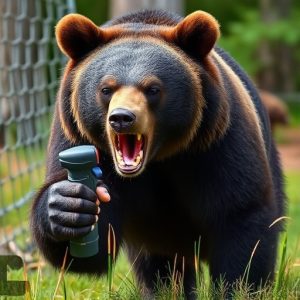Bear Repellent Spray: Ingredients, Choice, and Cruciality for Camping Safety
Understanding bear behavior is crucial for safe camping in bear country. Bears can become aggressive…….
Understanding bear behavior is crucial for safe camping in bear country. Bears can become aggressive if threatened, surprised, or near their cubs. Bear spray with active ingredients like capsicum and canola oil irritates bears' senses, causing them to flee. Not all bear sprays are equal; effectiveness varies by concentration, weather, and distance. Responsible use of bear spray, including proper technique, enhances safety. Selecting a spray with capsaicin, canethoic acid, pyrethrins, d-limonene, picaridin, or cinnamon oil is effective. The ideal bear spray depends on the environment, local bear species, and conditions like wind and bear activity. Always check product labels and practice safe handling.
“Maximize your camping experience and ensure a safe adventure with bear repellent spray – an essential tool every outdoor enthusiast should possess. Understanding bear behavior and knowing what chemicals are in bear spray (e.g., capsaicin, chili oil) is crucial for effective protection. This guide decodes the ingredients, offers tips on choosing the right bear spray, and highlights why this product is a camping essential. Prepare to navigate the wilderness with confidence.”
- Understanding Bear Behavior and Why Repellent Spray is Crucial
- Decoding the Ingredients: What's in Your Bear Repellent Spray?
- Choosing the Right Bear Spray for Your Camping Needs
Understanding Bear Behavior and Why Repellent Spray is Crucial
Understanding bear behavior is key to staying safe while camping in bear country. Bears are generally shy and will avoid humans, but they can become aggressive if they feel threatened, surprised, or if their young are nearby. They have an excellent sense of smell and rely heavily on it for foraging and navigation. This is where bear repellent spray comes into play as a crucial tool for campers.
Bear spray, also known as bear repellent, contains specific chemicals designed to deter bears. The active ingredients can include capsicum (a type of chili pepper compound), canola oil, and various other natural or synthetic compounds. When sprayed towards a bear, these chemicals irritate the animal’s eyes, nose, and respiratory system, causing it to flee the area. It’s important to note that not all bear sprays are created equal; the effectiveness depends on factors like the concentration of active ingredients, weather conditions, and distance at which the spray is deployed. Using bear spray responsibly, by learning the proper technique and understanding its limitations, can significantly enhance your safety during outdoor adventures in bear-inhabited areas.
Decoding the Ingredients: What's in Your Bear Repellent Spray?
When considering a bear repellent spray, it’s crucial to decode its ingredients list. Understanding what chemicals are in your bear spray can provide valuable insights into its effectiveness and potential safety concerns. Common active ingredients include capsaicin, which is derived from chili peppers, and canethoic acid, often found in pepper plants. These substances mimic the sensation of a mild burn, deterring bears by irritating their sensitive olfactory systems.
Other ingredients like synthetic or natural pyrethrins and d-limonene are also prevalent. Pyrethrins are insecticidal compounds known for their potency against various pests, including bears. D-limonene, meanwhile, is a citrus oil that can disrupt the scent masking mechanisms of bears, making them more aware of potential threats. Knowing what chemicals are in your bear spray allows informed decisions about its suitability for specific environments and personal preferences.
Choosing the Right Bear Spray for Your Camping Needs
When selecting bear repellent spray for your camping trips, understanding what chemicals are present is crucial. Active ingredients typically include capsaicin, a compound derived from chili peppers, and/or canola oil with a high concentration of capsaicin. These substances create an unpleasant sensory experience for bears, deterring them from approaching. Some brands also incorporate other agents like picaridin or cinnamon oil to enhance effectiveness.
The right bear spray depends on your specific camping environment. Factors like local bear species and their behavior influence the choice. For instance, black bears may require a lower concentration of capsaicin compared to grizzly bears. Check product labels for recommended usage based on distance, wind conditions, and bear activity in your area. Ensure you practice proper handling and safety measures when carrying bear spray during your outdoor adventures.
When venturing into bear country, having a reliable bear repellent spray is an essential part of your camping kit. By understanding bear behavior and choosing the right product with effective ingredients like capsaicin or chili pepper oil, you can minimize risks during outdoor adventures. Armed with knowledge about what chemicals are in bear spray and how to use it properly, campers can enjoy their time in nature while staying safe from unexpected encounters.


